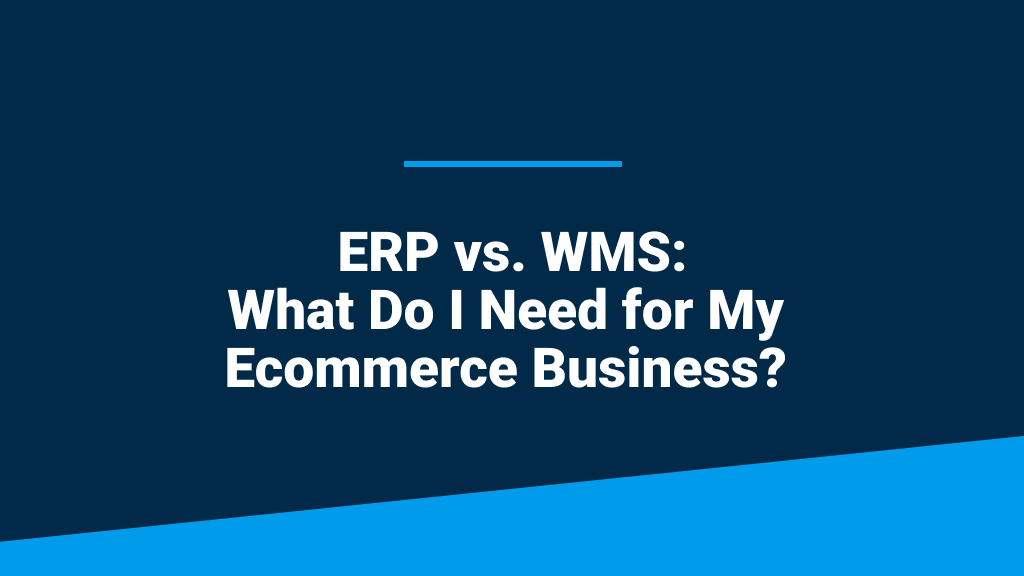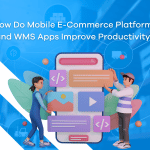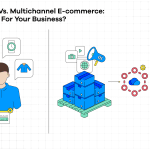
- ERP and WMS stand for ‘enterprise resource planning’ and ‘warehouse management system,’ respectively. An ERP system helps manage your entire business, while a WMS helps manage your warehouse, inventory, and operations.
- Using an ecommerce solution such as Descartes Sellercloud with a WMS like Skustack enables ecommerce sellers to handle the entirety of their operations and expand their business.
If you’re wondering if you need an ERP or WMS, you know you need a solution to help you manage your ecommerce business, but the difference may be confusing. First and foremost, ‘ERP’ and ‘WMS’ are not interchangeable three-letter acronyms. Though ecommerce companies can use both, they fulfill vastly different needs.
What you need depends on what best suits your business needs. For example, you might need a WMS but not an ERP, or you might have an ERP and want to integrate an external WMS.
Alternatively, another option is available to ecommerce sellers that is usually more appropriate—an ecommerce solution designed specifically for ecommerce sellers. You may find that an ecommerce solution with a WMS better suits your needs, or you may even decide to integrate one with your ERP or use all three.
There are many potential tech stack combinations, and understanding who they are most appropriate for is vital before deciding to make it a key part of your business operations.
In this article, we’ll explain how an ERP and WMS differ and help you understand if your business needs an ERP, WMS, or another kind of configuration.
What Is the Difference Between ERP and WMS?
A WMS helps a business thoroughly manage warehouse operations, while an ERP goes significantly further, helping manage an entire company. An ERP can help with:
- Finance management.
- Sales and customer relationship management (CRM).
- Supply chain management.
- Order processing.
- Manufacturing and project management.
- Compliance and risk management.
- Data and analytics.
- HR and time management.
An ERP may even have a WMS module. However, these modules are typically not as advanced as a full-fledged WMS designed specifically (and only) to tackle warehouse management. The WMS module of an ERP might not include advanced features such as wave picking and cycle counting, which are increasingly important for shipping orders quickly and maintaining inventory accuracy.
A standalone WMS can provide granular traceability, improve productivity, and handle returns better than most traditional ERPs. They can also bring a new level of insight to your business.
For example, an advanced WMS can optimize inventory placement within the warehouse using real-time data, so you can put it on the most convenient shelf and bin without needing to think about space utilization. You won’t likely get features like these from an ERP.
While a WMS cannot help you run your business, it can help you run your warehouse and make it highly efficient.
Do I Need an ERP or WMS for My Ecommerce Business?

The best software is the one that suits your business needs, so you must understand what those are before determining if you need an ERP, WMS, or a combination. If you manufacture the goods you sell, you need an ERP with a WMS module. If you do not manufacture goods, you may have a greater need for a standalone WMS.
According to an article by SelectHub, “Manufacturers represented the largest portion at 47% of companies looking to purchase ERP software.” They also added that: “Following manufacturers, distributors (18%), services (12%) and construction (4%) are the other industries most likely to use ERP software.”
As ERPs are often used by manufacturers, they can include features irrelevant to ecommerce sellers. ERPs can also be expensive, and you may be paying more for features you likely won’t need.
Meanwhile, a WMS typically comes with specific features that can help improve warehouse efficiency, which is typically in higher demand by ecommerce sellers, particularly when selling many products in different varieties.
A good example of how a WMS can be more beneficial to ecommerce sellers is returns management. According to a 2023 report by Flexport, 75% of merchants say that returns management is one of the top five most important services. Return Merchandise Authorizations (RMAs) are increasingly vital for ecommerce businesses, as they tend to handle more returns than brick-and-mortar stores.
According to a 2023 consumer returns report by the National Retail Federation, online sellers have a return rate of 17.6%, while pure brick-and-mortar retailers have a return rate of 10.02%. Having a full WMS instead of a WMS module can be beneficial because a WMS is more equipped to handle returns as it can segregate inventory.
When inventory is segregated, a WMS can create work orders for specific items. For example, someone can be tasked with checking returned orders to see if they are resalable. Even better, a good WMS can track RMAs so you know when returns will arrive in the warehouse. With an ERP, achieving the same level of functionality may require you to integrate additional services and adapt your workflow.
As an ecommerce company, you may find that an ecommerce solution and an integrated WMS will be more suitable for your business than an ERP with a WMS module, a standalone WMS, or an ERP integrated with a WMS. However, no two businesses are ever the same, and what might work for another business might not work for yours.
Whether you need an ERP, WMS, or a combination depends on your needs. Let’s examine some of the different scenarios and help you determine which will be more suitable.
Why You Might Need an ERP
As mentioned above, an ERP with a WMS module may be more suitable for your business if you manufacture goods versus a standalone WMS. Manufacturers typically do not struggle with complex warehouse tasks as much as ecommerce sellers.
It is worth considering your business’s short- and long-term goals and what features you need to accomplish them. SelectHub also states that 89% of businesses looking to implement an ERP said accounting was the most critical feature. After accounting, the most significant responses were inventory (67%), CRM (33%), manufacturing (24%), forecasting (24%), and integration (21%).
It may be the case that you already have a WMS, and as your company has grown, you need more accounting, CRM (Customer Relationship Management), and HR functionalities. In this case, you may consider dropping your current WMS for an ERP with a WMS module, though that can mean losing some crucial WMS functionalities.
Bear in mind that if you sell your products online, you may still need an ecommerce solution for marketplace integrations that can connect to your ERP (more on that later).
Why You Might Need a WMS
If your business only sells on one channel, like a brick-and-mortar business or wholesaler, or sells products on a single marketplace and you don’t manufacture your goods, you might not need an ERP or ecommerce solution and may only require a WMS to better manage your warehouse.
If you plan to use an ERP solely for inventory management, that may be overkill. An ERP can do a lot for a business, but it is usually not the most effective warehouse and inventory management tool. It would not be a cost-effective way to solve your challenge.
Regardless of how your business operates and what solutions you use, if you handle large order volumes, you may consider adding a WMS to your tech stack to better manage your orders, inventory, and workload.
Why You Might Need an Ecommerce Solution and WMS
You might need an ecommerce solution and WMS combination if you sell on multiple online marketplaces and your warehouse is becoming difficult to manage.
ERPs usually do not have many pre-built marketplace integrations to help you build a market presence, or help with marketing tasks like ad management. A WMS and ecommerce solution combination will work better if you want to gain marketplace exposure and ensure that each facet of your business is in compliance with the marketplaces you sell on.
Whether it provides accurate inventory or product listing feeds, downloading orders from channels, or synchronizing tracking numbers, a WMS and ecommerce solution would provide pre-built integrations and solutions to ensure smooth connectivity without custom development.
Not only would an ecommerce solution and WMS combination solve more of your challenges, but it would also be more cost-effective for your business.
According to Software Path research, the average cost per user is $9,000 annually. This is before considering subscription costs, onboarding and implementation fees, and integration costs (ERPs typically don’t have pre-built integrations with vendors, channels, and other external systems or solutions you use around your business).
Adding users to an ecommerce solution is typically much cheaper, with some solutions charging as little as $10 monthly per user. Descartes Sellercloud does not charge for additional users, implementation, or integrations.
Why You Might Need to Integrate a WMS with an ERP
A WMS ERP integration is a good option for manufacturers whose warehouse operations are getting too complicated. The ERP might already have a WMS module, but it might not meet all their needs, leading them to seek an external standalone WMS to integrate into their system.
For many businesses, WMS-ERP integration is ideal when their warehouse operations are becoming too complicated. They continue to rely on all the services they use from their ERP and use a comprehensive WMS to manage their warehouse.
Often integrated using an API connection, a WMS-ERP integration allows businesses to get all the features they need across the business and to work in harmony with one another as they direct the flow of information to a single source.
As mentioned above, some businesses benefit from using a WMS, ERP, and an ecommerce solution. They could need an ERP to manage their manufacturing operations, an effective standalone WMS to better manage their warehouse, and an ecommerce solution for marketplace integrations.
ERP vs. WMS vs. Ecommerce Solution – Descartes Sellercloud Supports All Setups

Descartes Sellercloud is an ecommerce solution built specifically for companies that sell online to handle all aspects of their ecommerce operations. It offers functionality similar to an ERP but at the price of an inventory and order management system.
Descartes Sellercloud is not just for online sellers. It is also an invaluable tool for manufacturers who use an ERP and want to expand into ecommerce. Sometimes, you need a bit of both—ERP and ecommerce solution—and Descartes Sellercloud fills that need for thousands of businesses. Even for large corporations, Descartes Sellercloud would be an excellent addition to your tech stack.
Farwest Sports is an example of a company that uses Descartes Sellercloud with an ERP to support its operations better.
“Sellercloud has completely streamlined how we do things, from how inventory flows up to all these different channels to how orders flow down and go straight into our ERP system,” said Don Grier, Director of Online Sales at Farwest Sports. You can read the entire Farwest Sports case study here.
Many businesses, like Farwest Sports, use Descartes Sellercloud for its channel connectivity and open API to send data to their ERP on a less granular level to simplify accounting operations.
Businesses don’t necessarily need an ERP to manage all their orders. Instead, Descartes Sellercloud can manage orders from various channels and marketplaces and bring in marketplace transactions to your ERP when they settle.
Descartes Sellercloud is also highly customizable, allowing some businesses to use it to replace their ERP and add needed functionality to their account.
While Descartes Sellercloud acts as the brain of your ecommerce operations, the Skustack WMS is the nervous system that helps you manage your warehouse and maximize efficiency. Skustack covers all the basics of warehouse management, from barcode scanning, inventory management, and cartonization to far more advanced features, including:
- Different types of picklists—FBA and WFS picklists, warehouse-to-warehouse transfer picklists, and vendor returns picklists.
- Kit assembling workflow.
- Serial number and LOT tracking.
Key features you won’t likely get from the WMS module of an ERP. Whatever your setup, Descartes Sellercloud can be your ecommerce gateway.
Watch the video below to see how Skustack helped 3PL Tobim Management take complete control over its inventory management and warehouse operations, resulting in more orders processed in less time.
Book a Descartes Sellercloud demo today.
Key Points
Remember these key points when thinking about the differences between ERP and WMS.
- WMS stands for warehouse management system, and ERP stands for enterprise resource planning. A WMS helps manage the warehouse, while an ERP helps manage a corporation.
- ERPs can (but not always) include a WMS module. WMS modules are typically not as advanced as a standalone WMS, which is usually more equipped for handling ecommerce operations.
- ERPs are used mainly by manufacturers and can lack the pre-built features, solutions, and integrations that an ecommerce company might need.
- The best solution for your business depends on your unique needs. Some businesses only need one solution; others can require a combination of ERP, WMS, and ecommerce solutions.
- Descartes Sellercloud is a cost-effective ecommerce solution built specifically for online sellers, and the Skustack WMS is designed to help businesses optimize their warehouses.




